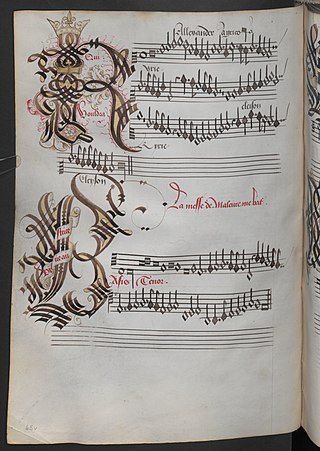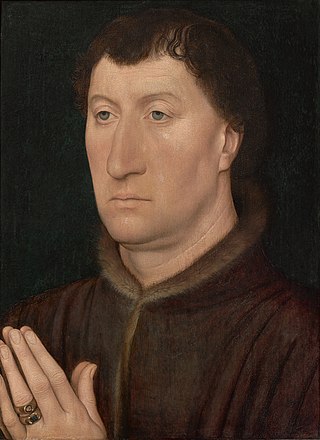Colinet de Lannoy (died before 6 February 1497) was a French composer of the Renaissance. He was one of the composers/singers working at the Milan chapel at the time of the assassination of Duke Galeazzo Maria Sforza in 1476, and he possibly also worked in France.
Very little is known for certain about his life, and some details have been confused with other musicians named "Lannoy" or "Lanoy". Two other singers named Lannoy, Jehan and David, were known to be active at the French court in the middle of the 15th century, and may have been related; in addition, a "Karolus de Launoy", active at Bourges and later in France, was previously confused with him. [1]
In 1477, Lannoy, along with Jean Japart, Johannes Martini, and Loyset Compère, was given a pass to leave Milan following the murder of Duke Galeazzo Maria Sforza. The singing group at the chapel had been one of the most distinguished in Europe, and the compositional style which developed there in the 1470s was widely influential: for example the motet-chanson was probably a Milanese invention. It is not known to what degree Lannoy was involved in the development of this style, nor is it known where Lannoy went after his dismissal. Most of the singers scattered, with Japart going to Ferrara, and Compère probably going back to France. Since one of Lannoy's known songs is in Dutch, he may have spent some time, either before or after Milan, in the Low Countries.
A line in Guillaume Crétin's elegy on the death of Johannes Ockeghem (6 February 1497) indicates that Lannoy had died by then.
Only two compositions are definitely attributed to Lannoy, both secular songs: Cela sans plus and Adieu natuerlic leven mijn. The former of these was used as a basis for mass settings by other composers, including Johannes Martini and Jacob Obrecht. [1]
One other piece has been considered as a possible composition by Lannoy, a partial cyclic mass for three voices. It is given to "lanoy" in the source, and the style is consistent both with Lannoy's songs and with that of other composers working at Milan. [1]

The House of Sforza was a ruling family of Renaissance Italy, based in Milan. They acquired the Duchy of Milan following the extinction of the Visconti family in the mid-15th century, Sforza rule ending in Milan with the death of the last member of the family's main branch in 1535.

Josquin Lebloitte dit des Prez was a composer of High Renaissance music, who is variously described as French or Franco-Flemish. Considered one of the greatest composers of the Renaissance, he was a central figure of the Franco-Flemish School and had a profound influence on the music of 16th-century Europe. Building on the work of his predecessors Guillaume Du Fay and Johannes Ockeghem, he developed a complex style of expressive—and often imitative—movement between independent voices (polyphony) which informs much of his work. He further emphasized the relationship between text and music, and departed from the early Renaissance tendency towards lengthy melismatic lines on a single syllable, preferring to use shorter, repeated motifs between voices. Josquin was a singer, and his compositions are mainly vocal. They include masses, motets and secular chansons.

Johannes Ockeghem was a Franco-Flemish composer and singer of early Renaissance music. Ockeghem was the most influential European composer in the period between Guillaume Du Fay and Josquin des Prez, and he was—with his colleague Antoine Busnois—the leading European composer in the second half of the 15th century. He was an important proponent of the early Franco-Flemish School.

Adrian Willaert was a Flemish composer of High Renaissance music. Mainly active in Italy, he was the founder of the Venetian School. He was one of the most representative members of the generation of northern composers who moved to Italy and transplanted the polyphonic Franco-Flemish style there.

Alexander Agricola was a Netherlandish composer of the Renaissance writing in the Franco-Flemish style. A prominent member of the Grande chapelle, the Habsburg musical establishment, he was a renowned composer in the years around 1500, and his music was widely distributed throughout Europe. He composed music in all of the important sacred and secular styles of the time.

Loyset Compère was a Franco-Flemish composer of the Renaissance. Of the same generation as Josquin des Prez, he was one of the most significant composers of motets and chansons of that era, and one of the first musicians to bring the light Italianate Renaissance style to France.
Gaspar van Weerbeke was a Netherlandish composer of the Renaissance. He was of the same generation as Josquin des Prez, but unique in his blending of the contemporary Italian style with the older Burgundian style of Dufay.

Franchinus Gaffurius was an Italian music theorist and composer of the Renaissance. He was an almost exact contemporary of Josquin des Prez and Leonardo da Vinci, both of whom were his personal friends. He was one of the most famous musicians in Italy in the late 15th and early 16th centuries.

Galeazzo Maria Sforza was the fifth Duke of Milan from 1466 until 1476. He was notorious for being lustful, cruel, and tyrannical.
Johannes Martini was a Franco-Flemish composer of the Renaissance.
Jean Japart was a Franco-Flemish composer of the Renaissance, active in Italy. He was a popular composer of chansons, and may have been a friend of Josquin des Prez.

Gilles Joye was a Franco-Flemish composer of the Renaissance. A member of the Burgundian school, he was known mainly for his secular songs which were in a lyrical and graceful style.
Firminus Caron was a French composer, and likely a singer, of the Renaissance. He was highly successful as a composer and influential, especially on the development of imitative counterpoint, and numerous compositions of his survive. Most of what is known about his life and career is inferred.
The name Lannoy or de Lannoy or of Lannoy can refer to
Johannes Ghiselin (Verbonnet) was a Flemish composer of the Renaissance, active in France, Italy and in the Low Countries. He was a contemporary of Josquin des Prez, and a significant composer of masses, motets, and secular music. His reputation was considerable, as shown by music printer Ottaviano Petrucci's decision to print a complete book of his masses immediately after his similar publication of masses by Josquin – only the second such publication in music history.
The motet-chanson was a specialized musical form of the Renaissance, developed in Milan during the 1470s and 1480s, which combined aspects of the contemporary motet and chanson.

Bonifacio Bembo, also called Bonfazio Bembo, or simply just Bembo, was a north Italian Renaissance artist born in Brescia in 1420. He was the son of Giovanni Bembo, an active painter during his time. As a painter, Bonifacio mainly worked in Cremona. He was patronized by the Sforza family and was commissioned to paint portraits of Francesco Sforza and his wife Bianca Maria Visconti. Scholars have credited him as the artist who produced a tarot card deck for the Visconti-Sforza families, now held in the Cary Collection of Playing Cards at Yale University. In the past century, art historians have begun to question the authenticity of his works, believing his only two secure works to be the portraits of Francesco and Bianca Maria Sforza. He is believed to have died sometime before 1482.
Jehan Fresneau was a French composer of the Renaissance. He was one of the composers in the renowned Milan chapel in the mid-1470s, which was disbanded after the assassination of Duke Galeazzo Maria Sforza.

Zanetto Bugatto, also known as Zanetto Bugatti, was one of the most well-documented court portraitists of the 1400s. A key painter of the Lombardy region, Bugatto worked for 15 years for the first two Sforza Dukes of Milan, particularly Duke Galeazzo Maria Sforza and his Duchess Bona of Savoy. His work was influenced by northern artists such as Rogier van der Weyden, Andrea Mantegna, and Jean Fouquet, all of whom he met during his travels. Bugatto's work was described by Galeazzo's ambassador Leonardo Botta as being similar to Sicilian painter Antonello da Messina. It is not clear whether Bugatto painted works other than portraits which he typically made on panel and in fresco. He is notable for being one of the first Italian artists, along with Antonello da Messina, to focus on portraiture in the Netherlandish style to such an exclusive extent.
The Casanatense chansonnier was a major collection of Renaissance vocal music made in Ferrara c. 1480, including compositions from Europe's leading composers.